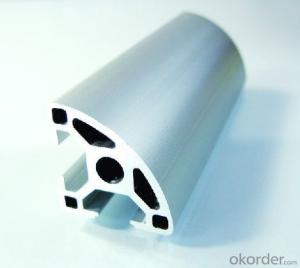Factory low price aluminium extrusion profile
OKorder Service Pledge
OKorder Financial Service
You Might Also Like
Aluminium is a relatively soft, durable, lightweight, ductileand malleablemetalwith appearance ranging from silvery to dull gray, depending on the surfaceroughness. It is nonmagnetic and does not easily ignite. A fresh film ofaluminium serves as a good reflector (approximately 92%) of visible lightand an excellent reflector (as much as 98%) of medium and far infraredradiation. The yield strength of pure aluminium is 7–11 MPa,while aluminium alloys have yield strengths ranging from200 MPa to 600 MPa. Aluminium has about one-third the densityand stiffness of steel. It is easily machined,cast, drawn and extruded.
Features:
Material | Alloy 6063,6061,6005or according to customer’s choice |
Temper | T3, T4, T5, T6 |
Surface | Anodize, electrophoresis, powder coating, PVDF coating, wood grain painting, matted, etc. |
Length | Coating 6.5 meters, Anodizing 6.5 meters, Mill finish 5 meters |
Application | Industrial, electrical equipment(TV set, air conditioner, refrigerator, computer), decoration,construction, transportation |
Custom Made | We can package following with customer's request. |
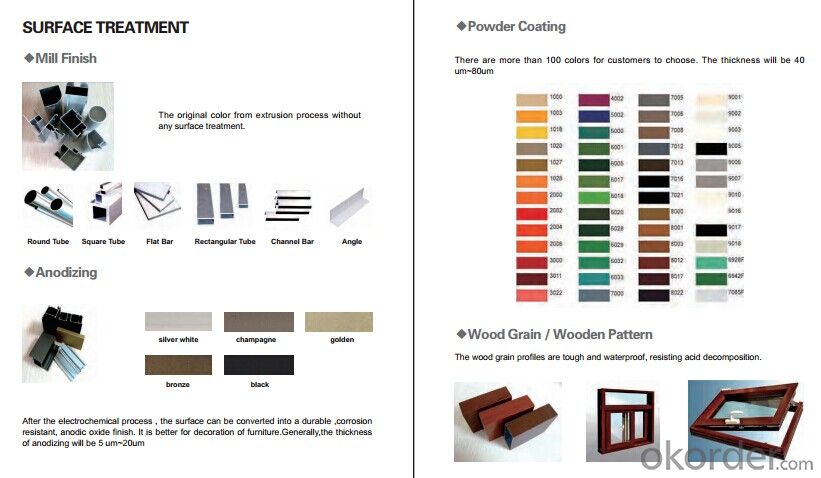

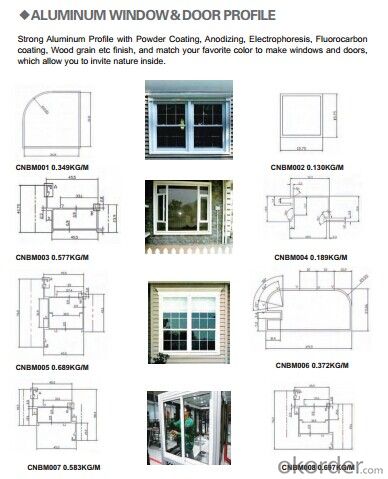
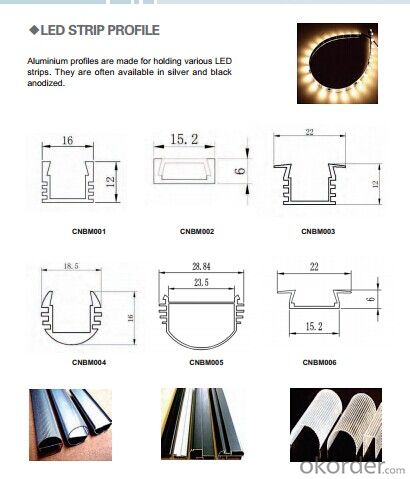
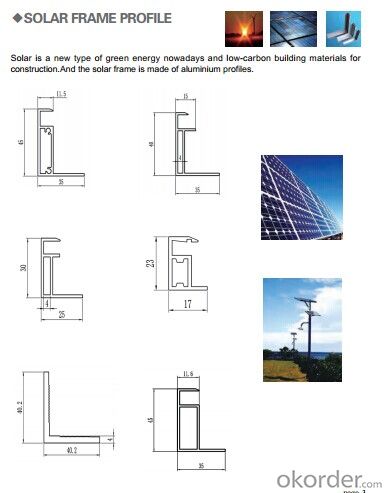
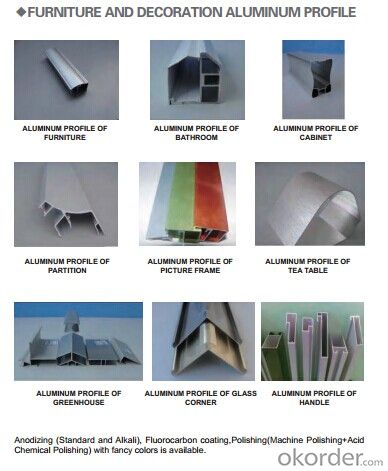
- Q:What are the specifications of aluminium alloy door and window profiles?
- The aluminum alloy door and window profiles of the same size series are quite complex in shape and size. Must be analyzed and treated in accordance with the drawings.The section of aluminum door and window profile is divided into solid section and hollow section according to the shape of section, and the application of hollow profile is larger.Aluminum door and window profiles of wall thickness, for aluminum alloy window of not less than 1.4mm, with aluminum alloy door is not less than 2mm.The length, size, dividing ruler, double ruler and indefinite ruler of aluminum door and window profiles are three kinds. Fixed length generally not more than 6m, variable length is not less than 1m.
- Q:What is the thickness of the aluminum alloy window frame?
- The national standard "Aluminum Alloy window" has been specified, aluminum wall thickness not less than 1.2 mm. In other words, the main wall thickness of ordinary aluminum alloy window structure should not be less than 1.2 mm, the main wall thickness of the door structure profiles should not be less than 2 mm.
- Q:What are the different powder coating options for aluminum profiles?
- There are several different powder coating options available for aluminum profiles, each offering unique advantages and characteristics. 1. Polyester powder coating: This is the most common and economical option for aluminum profiles. It provides excellent UV resistance and color retention, making it suitable for both indoor and outdoor applications. Polyester powder coatings are available in a wide range of colors and finishes, including matte, glossy, and textured. 2. Epoxy powder coating: Epoxy coatings offer excellent adhesion and corrosion resistance, making them suitable for demanding environments such as marine or industrial applications. They have good chemical resistance and are often used as a primer before applying a topcoat for added durability. 3. Polyurethane powder coating: Polyurethane coatings provide exceptional durability and resistance to abrasion, making them ideal for high-traffic areas or surfaces that are prone to wear and tear. They offer excellent color retention and gloss retention, ensuring a long-lasting finish. 4. Fluoropolymer powder coating: Fluoropolymer coatings, such as PVDF (polyvinylidene fluoride), are known for their outstanding resistance to chemicals, UV radiation, and weathering. They are highly durable and provide excellent color retention, making them suitable for architectural applications where long-term performance is essential. 5. Hybrid powder coating: Hybrid coatings are a combination of epoxy and polyester resins, offering a balance of excellent adhesion and color retention. They provide good weather resistance and are often used in general-purpose applications where cost-effectiveness is a priority. It's important to consider the specific requirements of your project when choosing a powder coating option for aluminum profiles. Factors such as intended use, environmental conditions, and desired aesthetics will help determine the most suitable option for achieving the desired performance and appearance.
- Q:Can aluminum profiles be used for access platforms?
- Yes, aluminum profiles can be used for access platforms. Aluminum is a lightweight and durable material that is commonly used in construction and industrial applications. It is known for its corrosion resistance and high strength-to-weight ratio, making it suitable for access platforms. Aluminum profiles can be easily fabricated into various shapes and sizes to meet the specific requirements of an access platform. Additionally, aluminum is also non-magnetic and non-sparking, which can be advantageous in certain environments. Overall, using aluminum profiles for access platforms can provide a safe and reliable solution.
- Q:What are the fire-resistant properties of aluminum profiles?
- Aluminum profiles offer a range of fire-resistant qualities that render them suitable for a variety of uses. Firstly, aluminum boasts a remarkably high melting point of around 660 degrees Celsius (1220 degrees Fahrenheit), enabling it to endure extreme temperatures without succumbing to melting or compromising its structural integrity. Furthermore, aluminum possesses a low ignition point, necessitating a higher temperature than other metals to ignite. This attribute reduces the likelihood of aluminum catching fire when exposed to heat or flames. In the event of a fire, aluminum profiles generate a protective layer of aluminum oxide on their surface owing to their innate oxide layer. This layer acts as a barrier, impeding the propagation of flames and hindering the combustion process. Moreover, the aluminum oxide layer exhibits exceptional heat resistance, thereby providing supplementary defense against elevated temperatures. Additionally, aluminum profiles are non-combustible, meaning they do not contribute to the expansion of a fire. This characteristic assumes critical importance in ensuring fire safety by containing the fire within a specific zone and averting rapid spreading. Taken together, the fire-resistant attributes of aluminum profiles, encompassing their high melting point, low ignition point, the formation of a protective oxide layer, and non-combustibility, establish them as a dependable choice for a wide range of applications where fire safety is a paramount concern.
- Q:High compartment aluminum profiles are generally divided into several specifications, what are the attributes?
- Aluminum alloy profiles are basically no GB non-standard, but the state has special specifications for architectural aluminum profiles, mainly on the thickness of the material, materials and so on.Each aluminum alloy profiles manufacturing enterprises are basically similar products, but in specific structure of the discrepancy. But such as the more general series, such as GB 50, 868, and 90, these are basically the same.The 80 series and the 60 series refer to the aluminium alloy profiles with widths of 80 mm and 60 mm.
- Q:Can aluminum profiles be used for creating display systems?
- Yes, aluminum profiles can be used for creating display systems. Aluminum profiles are lightweight, durable, and easy to work with, making them ideal for constructing various types of displays such as exhibition stands, trade show booths, and retail displays. They can be easily customized and allow for modular designs, enabling flexibility in creating unique and eye-catching display systems. Additionally, aluminum profiles offer a sleek and professional appearance, making them a popular choice in the display industry.
- Q:Can aluminum profiles be used in construction?
- Yes, aluminum profiles can be used in construction. Aluminum is a lightweight, durable, and corrosion-resistant material, making it suitable for various construction applications. It is often used in the construction of windows, doors, curtain walls, and roofing systems. Aluminum profiles offer flexibility in design, allowing for the creation of complex shapes and structures. Additionally, aluminum is a sustainable material as it is highly recyclable, making it an environmentally friendly choice for construction projects.
- Q:Are there any safety considerations when working with aluminum profiles?
- Yes, there are several safety considerations that should be taken into account when working with aluminum profiles. Firstly, it is important to wear appropriate personal protective equipment (PPE) such as gloves, safety glasses, and a dust mask when handling aluminum profiles. This is because working with aluminum profiles can generate fine metal shavings and dust, which can be harmful if inhaled or come into contact with the skin or eyes. In addition, it is important to ensure proper ventilation in the work area to minimize the accumulation of aluminum dust and fumes. This can be achieved by using exhaust fans or opening windows and doors to allow fresh air to circulate. When cutting or machining aluminum profiles, it is crucial to use the correct tools and techniques to prevent accidents or injuries. This includes using sharp blades or cutting tools specifically designed for aluminum, as using improper tools can lead to kickback or other hazards. Furthermore, it is important to handle aluminum profiles with care, as they can have sharp edges or corners that can cause cuts or injuries. Proper lifting techniques should be used to avoid strain or back injuries when moving or installing aluminum profiles. Lastly, it is important to be aware of the potential fire hazards associated with aluminum dust. Aluminum dust is highly flammable and can ignite if exposed to an ignition source, such as a spark or open flame. Therefore, it is important to maintain a clean work area and regularly remove any accumulated aluminum dust to minimize the risk of fire. Overall, by following these safety considerations and taking necessary precautions, the risks associated with working with aluminum profiles can be minimized, ensuring a safe working environment.
- Q:Are aluminum profiles suitable for exhibition kiosks?
- Indeed, exhibition kiosks greatly benefit from the use of aluminum profiles. With its lightweight and durable nature, aluminum proves to be the ideal material for constructing kiosks that are easily portable and transportable. Its robustness ensures the creation of stable and reliable structures, guaranteeing the safety of both exhibitors and visitors. Moreover, the versatility of aluminum profiles allows for effortless customization and assembly, granting flexibility in design and layout. In addition, their sleek and contemporary appearance enhances the overall aesthetics of the exhibition kiosk. Furthermore, the corrosion-resistant properties of aluminum make it suitable for both indoor and outdoor use, even in challenging environmental conditions. Ultimately, the exceptional combination of versatility, durability, and aesthetic appeal makes aluminum profiles an outstanding choice for exhibition kiosks.
1. Manufacturer Overview |
|
|---|---|
| Location | |
| Year Established | |
| Annual Output Value | |
| Main Markets | |
| Company Certifications | |
2. Manufacturer Certificates |
|
|---|---|
| a) Certification Name | |
| Range | |
| Reference | |
| Validity Period | |
3. Manufacturer Capability |
|
|---|---|
| a)Trade Capacity | |
| Nearest Port | |
| Export Percentage | |
| No.of Employees in Trade Department | |
| Language Spoken: | |
| b)Factory Information | |
| Factory Size: | |
| No. of Production Lines | |
| Contract Manufacturing | |
| Product Price Range | |
Send your message to us
Factory low price aluminium extrusion profile
OKorder Service Pledge
OKorder Financial Service
Similar products
New products
Hot products
Related keywords

